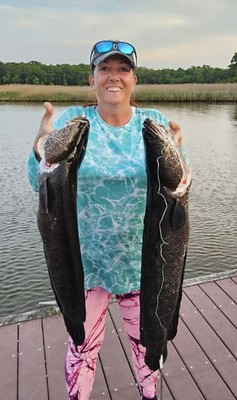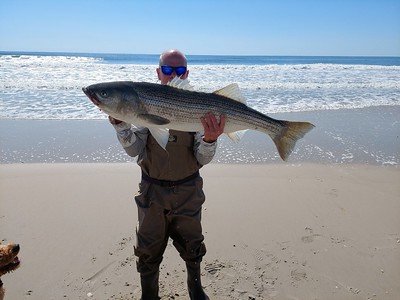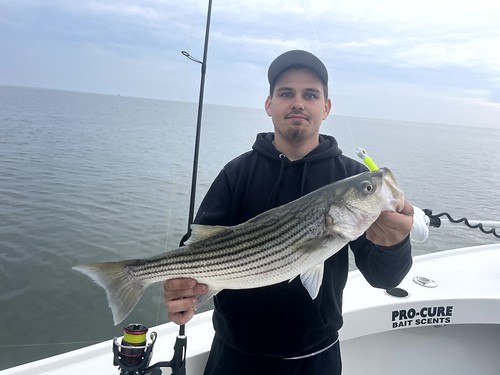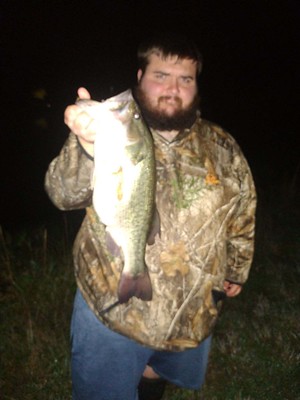
Tyler Ferenschak was on a quest to catch a northern snakehead and he finally caught one on the Middle River. Photo by Matt Ferenschak
All kinds of fishing opportunities are available this week for anglers, from the mountains of western Maryland to the coastal waters of the Delmarva Peninsula. Seasons are open for striped bass season in the Chesapeake Bay and black sea bass in the Atlantic Ocean, and many other species of fish are active as water temperatures warm.
There are new striped bass regulations now in effect in the Chesapeake Bay and coastal waters. Anglers may keep one striped bass per person per day, with a minimum length of 19 inches and a maximum length of 31 inches. A smaller maximum size of 26 inches is in place in the Susquehanna Flats, Lower Susquehanna River, and North East River from May 18 through May 31, then the bay-wide size limits apply.
In Maryland’s portion of the Atlantic Ocean and its coastal bays, which are open to striped bass fishing all year, anglers may keep one striped bass per person per day, with a minimum length of 28 inches and a maximum length of 31 inches.
All other rules remain the same.
If you do take part in the Maryland striped bass season, please participate in our volunteer angler survey. The information received from anglers is a valuable resource for biologists to better understand recreational fishing for striped bass in Maryland. There are multiple species you can help with also – check the Department of Natural Resources website to search for all our volunteer angler surveys.
Forecast Summary: May 17 – May 23:
Continued warm weather in the upcoming week will keep water temperatures rising for Chesapeake Bay gamefish. Main Bay surface water temperatures have risen about three degrees since last week, to the mid to upper 60s.
Bay salinity is still above average. Some areas of low oxygen are appearing in the bottom waters along the lower western shore and Potomac River, from the Bay Bridge down to the mouth of the river, and from Colonial Beach to Breton Bay. However, there are still plenty of cool, well oxygenated areas in the Bay to pursue gamefish.
Expect below average flows all week. There will be above average tidal currents all week as a result of the upcoming new moon on May 19. Expect average water clarity in Maryland’s bay, rivers, and streams. To see the latest water clarity conditions, check Eyes on the Bay Satellite Maps.
As always, the best fishing areas could be further refined by intersecting them with underwater points, hard bottom, drop-offs, and large schools of baitfish.
For more detailed and up-to-date fishing conditions in your area of the Bay, be sure to check out Eyes on the Bay’s Click Before You Cast.

Zolita Courter holds up two large snakeheads caught in Dundee Creek. Photo courtesy of Zolita Courter
Anglers have begun fishing for striped bass from the Conowingo Dam pool down to the Susquehanna Flats. Remember the slot size to keep striped bass caught in that area will be 19 inches to 26 inches until June 1, at which point the maximum increases to 31 inches. The catch limit is one fish per angler per day all season.
There is still a closure period for waters below the Susquehanna Flats – to avoid confusion anglers are encouraged to be familiar with the striped bass regulation map on the Department of Natural Resources website.
Anglers are still catching and releasing a few hickory shad at the Conowingo Dam, and although we had no reports from the weekend there may still be some hickory shad activity in Octoraro Creek. There are plenty of flathead catfish in the dam pool.
Many are enjoying good luck jigging with soft plastics near the Love Point rocks, the Bay Bridge piers, and along steep channel edges where striped bass can be located. Others are trolling them behind umbrella rigs or in tandem and have dropped the size of their bucktails and swim shads to medium. The shipping channel edges tend to be popular places to troll. Other anglers will try chunking and chumming near channel edges and besides catching striped bass, will be kept busy with a mix of channel and blue catfish. Anglers are reminded that they must use non-offset circle hooks when targeting striped bass with bait. Drifting cut baits or soft crab baits back towards the bases of the Bay Bridge piers is also a good way to target striped bass.
A mix of channel and blue catfish can be found in the lower Susquehanna River, the other tidal rivers of the upper Bay, and out in the Bay itself. Any type of fresh cut bait, wild shrimp from the grocery store, chicken liver, scented bait, and nightcrawlers all make fine baits. The lower Susquehanna and the Chester River have some of the highest populations of blue catfish in the upper Bay.
Northern snakeheads are entertaining anglers throughout the region this week. The snakeheads are very active and striking baits in the tidal rivers and creeks. Paddletails tend to be one of the favorite lure choices but large minnows under a bobber work well also.
White perch can be found in the lower sections of the region’s tidal rivers, usually in deeper waters during the day and shallower in the evening. Grass shrimp or pieces of bloodworm can be fished on a simple one-hook bottom rig that is constructed so the baited hook is about 5-6 inches off the bottom. Use as little weight as possible. In the evenings white perch can be found near shoreline structures in the form of rocks, sunken wood, and dock piers.
The long-awaited summer striped bass season is finally underway and recreational anglers can enjoy fishing for keepers that are 19 inches to 31 inches in length. Fishing will pick up when calmer wind conditions arrive.
Jigging is a great way to fish for striped bass and anglers will be seen checking out channel edges, steep drop-offs, and similar structure. Depth finders are a valuable tool when searching for suspended striped bass. Thomas Point is often a great place to start looking. Most are using soft plastic jigs in various colors but shades of chartreuse are one of the most popular colors. Metal jigs in the form sting silver and Crippled Herring type lures are being used. We received a report from an angler named John that he had good luck catching and releasing several striped bass in the South River near the bridges.
Trolling is a popular option in traditional locations along the edges of the shipping channel. Popular choices for trolling are umbrella rigs with bucktails or swim shads as trailers, or bucktails rigged in tandem. All rigs will need some weight where the striped bass are suspended deep. Spoons can also be a productive choice when rigged behind inline weights or planers.
The Choptank River will remain closed to striped bass fishing until June 1, but when it opens, casting topwater lures along the shorelines of the lower Choptank below Cambridge will entertain shallow-water anglers. In the meantime, there are plenty of channel and blue catfish in the river above Cambridge, with some of the best opportunities upriver from the town of Choptank. White perch are now being found in the lower sections of the region’s tidal rivers and creeks, often near structures in the form of docks, rock jetties, and oyster bars.
Happy times are here for lower bay anglers who love to fish for striped bass, as the minimum size is now reduced to 19 inches in Maryland waters, with a coastwide maximum of 31 inches for all Atlantic states. Jigging is a favored method of fishing and striped bass will be found along channel edges, drop-offs, points, and the mouths of the region’s tidal rivers. The cuts through Hoopers Island are always a great place to cast across current and jig in the walk-the-dog fashion using soft plastic jigs or bucktails dressed with a soft plastic curly tail. This is one of the spots where you never know what will strike – a striped bass, speckled trout, red drum, or perhaps a flounder.
The Cedar Point rocks is another favored spot for casting topwater lures, paddletails, and jerkbaits up close to the rocks in the early morning or evening hours, and work soft plastic jigs in the deeper waters during the day. The Calvert Cliffs Power Plant warm water discharge is another popular location to drift and jig close to the bottom with a variety of jigs.
A good depth finder is an important tool when searching for suspended striped bass along deep channel edges; once found vertical jigging with light tackle is one of the most exciting ways to fish for striped bass.
Trolling is a popular option, especially on the larger boats, and they will be pulling a variety of setups. Planers and inline weights can be used to get spoons down to where the fish are holding. Tandem-rigged bucktails and swim shads are popular behind inline weights, and finally there are the umbrella rigs that are a lot to reel in but it works out fine when there is a striped bass hooked on the trailer. Swim shads and bucktails are common trailers.
The lower Potomac River offers plenty of good striped bass fishing this week; the tidal Potomac has the bonus of being able to keep two striped bass per day if they measure 20 inches to 31 inches.
Some anglers will be chunking or chumming at favorite locations and in many areas will have their hands full with blue catfish being attracted to their chum slicks or drifting chunks of cut bait. Drifting peeler or soft crab baits along channel edges and the mouths of creeks flowing into Tangier and Pocomoke sounds is a very productive way to target striped bass and speckled trout. A few black drum have been caught in the area and red drum will arrive soon.
If anyone is looking for some nonstop action, there are plenty of blue catfish to be caught in the tidal Potomac, the Patuxent, the Nanticoke, and numbers of blue catfish are increasing in the Wicomico and Pocomoke rivers. There are also charter boats that are offering blue catfish trips on the tidal Potomac.
White perch are now being found near the mouths of the region’s tidal rivers and creeks and can be caught on grass shrimp or pieces of bloodworm on bottom rigs. They will also begin to move into Tangier Sound. The mouth of the Patuxent is usually a great place to target them on the oyster bars.
Anglers are enjoying some of the best freshwater fishing opportunities this week as conditions are just about perfect. Water temperatures are moderate, the weather is nice, and fish such as largemouth bass and smallmouth bass are in a post-spawn mode of behavior and feeding aggressively.
Anglers at Deep Creek Lake are finding good conditions for fishing for a mix of species. Largemouth and smallmouth bass can be found near floating docks. The largemouth tend to be in shallower waters and often near grass or shoreline structure. Smallmouth like slightly deeper waters near rocky points and those floating docks.
The upper Potomac River is clearing up and flows moderating, but anglers in small boats need to take utmost caution. Water temperatures are in the mid-60s and smallmouth bass can be found near current breaks, underwater ledges, and rock cover. A variety of lures make good choices including tubes, stickbaits, swimbaits, and crankbaits.
Largemouth bass are entertaining anglers across Maryland from the smallest of farm ponds to our largest reservoirs and tidal rivers. Cover in the form of grass, spatterdock fields, lily pads, and sunken wood are good places to target. At this time of the year when water temperatures are moderate, largemouth bass can be found in a variety of locations during a large part of the day. Shallow grass is always a fun place to use topwater lures in the form of frogs, buzzbaits and poppers. When fishing in tidal waters watch out for northern snakeheads and if you suspect a strike from one, give it a second before setting the hook – they are famous for short strikes.
Soft plastics and stick worms are often rigged in many different fashions and are a great bait to use around deeper grass and structure. Jerkbaits and spinnerbaits can also be a great choice in these transition areas. The mouths of small feeder creeks in tidal waters can also be a good place to target.
This week is a great time to target crappie in ponds, lakes, reservoirs, and tidal waters. Most anglers fish with small marabou jigs or minnows near deep structure. Sunken brush, bridge piers, marina docks, and fallen treetops all fit the bill.

Don Hisler caught and released this 46-inch striped bass at Assateague. Photo courtesy of Don Hisler
Along the beaches of Assateague anglers are catching a variety of fish in the surf. Striped bass are being caught on cut bait, clams, bloodworms, and sand fleas. Bluefish are being caught on cut bait and sting rays seem to like all baits that are being fished.
Inshore sharks are beginning to show up along the beaches; most are protected and if accidentally hooked they must be released in the water immediately; do not take any Rambo pictures of sharks hauled up on the beach. Check the Department of Natural Resources website for information on Maryland sharks. NOAA also has a website to help with shark identification.
Striped bass fishing is very good this week near the South Jetty, around the Route 50 Bridge and nearby piers, and at the Route 90 Bridge. Casting soft plastic jigs and paddletails are the most popular lures being used. Large bluefish are showing up here and there and unfortunately will tear up soft plastic baits.
Flounder continue to pour through the inlet and fill up the back bay waters. The channels leading away from the inlet are the place to be, with the Thorofare and East Channel most popular.
The 2023 black sea bass season opened this week and reports of limit catches were common. The sea bass season will run until September 30 and then reopens October 10 to December 31. The daily creel limit is 15 fish per day at a 13-inch minimum. Tautog season is closed and will reopen July 1 to October 31 with a two fish per day creel limit and a 16-inch minimum.
Anglers heading out to the canyons are enjoying good deep drop fishing for a mix of golden and blueline tilefish, along with a few protected sharks being caught and released. The Maryland Department of Natural Resources and the National Marine Fisheries Service designed a mandatory reporting program to monitor recreational landings of bluefin tuna, swordfish, billfishes, and sharks (except spiny dogfish) in Maryland. Anglers landing in Maryland MUST report at a state-operated station, and may not use phone, app, or online options. Anglers can visit the online catch card reporting page to learn more about this program and its requirements.
“Zane Grey once remarked to the effect that there was never an angler who lived but that there was a fish capable of taking the conceit out of him.” – Ralph Bandini
Maryland Fishing Report is written and compiled by Keith Lockwood, fisheries biologist with the Maryland Department of Natural Resources.
Click Before You Cast is written by Tidewater Ecosystem Assessment Director Tom Parham.
This report is now available on your Amazon Echo device — just ask Alexa to “open Maryland Fishing Report.”
"fish" - Google News
May 18, 2023 at 02:47AM
https://ift.tt/ebt3KYo
Maryland Fishing Report – May 17 - maryland.gov
"fish" - Google News
https://ift.tt/bdYIx9Q
https://ift.tt/np4LoJc
Bagikan Berita Ini
















0 Response to "Maryland Fishing Report – May 17 - maryland.gov"
Post a Comment